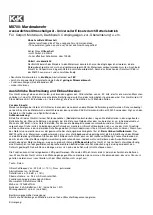
>@9
Multitone Audio Test System
User Manual
36 / 71
V
3.32
12. It is recommended to transmit the burst at a defined time, so that the operator of the
analyzer realizes immediately, whether the trigger has been detected or not.
If no successfull line measurements are possible, read the chapter
Application Hints /
Troubleshooting
(p.
37
) to check possible causes and work out solutions.
Trigger Configuration
The most important topic of broadcast mode measurements with
>@9
is the definition and
application of an appropriate trigger. For this purpose, three trigger configurations are
provided.
•
LOOSE - standard configuration for industrial applications (noisy signals with a poor
dynamic range, or internal link between generator & analyzer). The trigger condition is
met rather easily, i.e. false triggerings have to be expected if the multitone signal is
introduced into an ordinary broadcast program etc.
•
TIGHT - special configuration for broadcast applications. The trigger condition has been
tightened by far vs.
LOOSE in order to avoid false triggerings. Requires an accurate
setting of the generator output level and analyzer input range.
•
USER - this parameter allows to define the trigger condition according to user-specific
demands. However, since this application requires a very thorough and detailed
understanding of the whole triggering complex, this approach is for very advanced users
only, who have a profound understanding of all possibilities and their consequences.
ATTENTION Improper configuration of the USER trigger may result in a ’always’ or
’never’ condition, where the analyzer triggers on almost every incoming
signal (music, speech etc.) or never recognizes any trigger, even if it is a
correct one.
The trigger signal of a
>@9
multitone burst comprises three signal bins at different
frequencies and with individual levels. In order to avoid false triggerings, the receiving
>@9
permanently monitors the input signal on strictly this pattern. Furthermore, the analyzer
checks whether two more, predefined signal bins are ’empty’, i.e. whether no level can be
detected at these two
frequencies. If this is the
case, the analyzer
recognizes the incoming
signal as a
>@9
multitone burst and
triggers to it.
Fig. 24
visualizes the
characteristic of a
>@9
triggersignal. The bottom
bars (
T
) at the fre-
quencies 1, 3 and 5 rep-
resent the set signal bins
and their amplitudes, de-
fined against the ground
level of the generator,
whereby signal bin 1 and 5 have identical amplitudes. The frequencies 2 & 4 represent the
empty bins.
Amplitude [dB]
Frequency
a
1
2
3
4
5
c
c
b
0dB
a
Fig. 24 Trigger Definition
















































